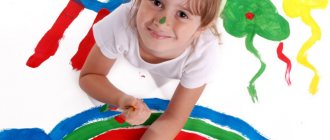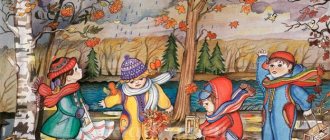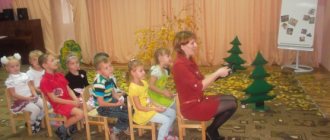Card index of walks
Drawing up a plan for outdoor leisure requires taking into account a number of important points:
- the topic should have something in common with other classes;
- variability is important, since the weather can make its own adjustments (usually the teacher indicates 1-2 alternative topics in the calendar planning for each week);
- the emphasis on this or that activity is done based on the individual characteristics of a particular team (for example, if the kids are athletic, then you can’t do without enhanced physical training during a walk).
Table: sample of drawing up a calendar-thematic plan for walks
| date | Subject | Kind of activity | Tasks | Techniques |
| Autumn | "Wonders of the Wind" | Observation | Strengthen the ability to record changes in nature, tell why and why leaves fall | Game “Pathfinders. Which leaves win” (children analyze which trees there are more on the site) |
| Work | Involve children in helping with plant care as much as possible | Kids shelter flowers from the cold, raking fallen leaves under local trees and bushes | ||
| Games | Train in running, jumping, agility | "Zarnitsa", "Fishing Rod" | ||
| Individual approach | Improve physical fitness, work on developing memory and attention | The game “Get a leaf” for active children, the game “I will put it in the basket” for sedentary children | ||
| Spring | "We are athletes" | Observation | Arouse emotional attitudes towards animals, insects and plants | Discussion of the body structure features of butterflies |
| Work | Learn to run errands on time | Game “Who is faster” (kids collect garbage at speed) | ||
| Games | Develop motor creativity and attention | “Salki”, role-playing games at the discretion of children | ||
| Individual approach | Develop the ability to draw symmetrical images (for overly active children) | Game "Complete the Draw" |
Table: summary of a walk in a preparatory group for school
| Author | Slesarenko Natalia |
| Name | “Expedition through the territory of the kindergarten” |
| Content | < Time of year: late autumn (November). Preliminary work:
Take-out materials: feeders, turntables, spatulas, flags, plastic molds, wooden pencils, multi-colored water in plastic bottles, red and blue ribbons for outdoor play. Goal: increasing vitality through new impressions and knowledge about the environment. Tasks:
<… Observation (central entrance). Q: Guys, do you think weather conditions are important for forwarders? D.: Yes. Q: What weather is best for hiking? D.: Good, windless, clear, sunny. Q: What can we say about the weather now? (Listens to the children’s answers) How can you determine whether there is wind or not? (Look at the trees, turn in different directions and feel the wind with your face, hand, using a flag, ribbon) Q: How can we determine which direction the wind is blowing? D.: Look at the trees (where the trees lean means the wind is blowing in that direction, using a flag or a pinwheel). Children determine the direction of the wind. V.: I suggest playing the game “North and South Wind”. Children choose drivers using a counting rhyme. There are two drivers in the game. The first person is tied with a blue ribbon on his hand - this is the “north wind”, the other - a red one - this is the “south wind”. The rest of the children are running around the playground. “North Wind” tries to “freeze” as many children as possible (touch them with your hand). “Frozen” children take some pose. The “South Wind” “defrosts” them by touching them with his hand, exclaiming: “Free!” After 2-3 minutes, new drivers are appointed, and the game is repeated. V.: Well done, now look at the photo and guess where we will go? (The teacher shows a photograph of the object: the veranda of our site) For a successful expedition, let's remember our motto. D.: “We are smart, we are attentive, we are diligent and everything will work out for us!” V.: And, like real forwarders, let’s walk like a “skier.” Children line up in a column one at a time. When we reach the turn, the teacher asks where to go next (left, another left, straight, right). They walk to the veranda in different ways (snake, step over high snowdrifts, side gallop)…> <… Individual work: drawing on the snow with wooden pencils (drawings from geometric shapes). The teacher praises the children. Q: Guys, where do you think birds gather most during the cold season? (Where there are a lot of trees) Q: Is there such a place on the territory of the kindergarten? Who can lead our expedition there? They continue their journey with different walks: “skiers”, side gallop, “high snowdrifts”, “snake”. They reach the main entrance and enter an area with trees. Q: Guys, what do you call the birds that do not fly south, but stay with us? (Wintering). What wintering birds do we often see visiting birch trees? (Crows, sparrows, magpies). How can we help birds survive a harsh, windy winter? V.: Let's remember the poem: It is difficult for birds to winter, We must help the birds! I asked him to cut a spruce board, and together with my dad I made Bird’s dining room. (A. Chepurov) V.: Our children, together with their parents, also made feeders for the birds, let’s hang them up and, going out for a walk every day, we will pour food for the birds. V.: Guys, I think the birds will be very happy and grateful to you. Result: Today on our walk we were pathfinders, we learned a lot of interesting things about the properties of snow, the friends of trees, and wintering birds. But the most important thing? D.: We were nature’s helpers: we pleased the birds with feeders, took care of the young trees, covered them with fluffy snow so that their roots would not freeze. V.: Thank you very much for this! You made me very happy with your knowledge, remain as attentive and caring towards all living things! V.: Let’s take a photo as a souvenir and tell the children in kindergarten how usefully we spent today’s walk...> |
| Source | Quote from: https://www.maam.ru/detskijsad/progulka-v-podgotovitelnoi-grupe-analiz-progulki.html |
Time plan for the walk
Like any other type of educational activity, the walk must be carefully planned in time. For the preparatory group, the timing is as follows:
- observation - 5–25 minutes;
- labor activity - 7–15 minutes;
- physical activity, including outdoor games - 20–25 minutes in the morning, 12–15 minutes in the evening;
- individual work - 7–15 minutes.
Typically, time delays occur during the play phase: children do not want to change the type of activity
Topic: “Excursion to the autumn park”
- Observation - 20 minutes. Conversation on questions (What new can we observe in the park?, How is the park different today from what we saw in the summer? etc.), the game “I am a birch tree” (kids take turns imagining themselves as trees and using their facial expressions they show what exactly).
- Labor - 20 minutes. Children collect seeds of various plants in separate boxes.
- Physical activity - 25 minutes. Games “Birdcatcher” (a child standing in a circle, blindfolded, tries to catch the one who gave the voice), “Recognize a friend by his voice” (the driver inside the circle closes his eyes, completes all the tasks of the participants, and then tries to guess who is calling him) .
- Individual work - 15 minutes. For active children, the task is to run up to the tree that the teacher names, for calm kids - “Sparrows”: the participants move forward in small jumps.
Topic: “The winds blow in February”
- Observation - 5 minutes. Children use pinwheels to determine the direction of the wind. An explanation of how drifts appear on roads and what drifting snow is.
- Labor activity - 15 minutes. Children remove snow from the paths with the help of shovels and brooms, decide where to place the collected snow, and also create a snow woman.
- Play activity - 10 minutes. Role-playing fun using snow structures and a built snowman. For example, a snowball fight.
- Individual work - 10 minutes. Active children ski, less active children learn to balance on an ice ring.
Structural elements can be combined in different ways, so time periods sometimes change within 5–10 minutes. The duration of the children’s stay in the air is determined by climatic conditions, but it is carried out 2 times a day: after breakfast and after afternoon tea.
This is interesting. According to SanPiN 2.4.1.3049–13 “Sanitary and epidemiological requirements for the structure, content and organization of the operating mode of preschool educational organizations,” approved. By Decree of the Chief State Sanitary Doctor of the Russian Federation dated May 15, 2013 No. 26, the recommended duration of daily walks is 3–4 hours.
Article SanPiN
https://www.maam.ru/detskijsad/statja-progulki-dlja-raznyh-vozrastnyh-grup.html
Objects and topics of observation during walks in the preparatory group
On a note! Walks in the preparatory group of the file cabinet with goals for the Federal State Educational Standard should be carried out on a specific topic. The choice of topic is determined by the possibility of observing certain objects.
The location of the walk, weather conditions and additional factors also matter.
Transport observations
It is better to divide vehicle observations into several parts depending on the type of vehicle or driver actions.
- General surveillance of transport. The goal is to familiarize children with different types of cars. Preschoolers should clearly distinguish between the concepts of trucks, buses and cars. It is necessary to determine the basic functions of all modes of transport. It is necessary to distinguish the elements and parts of the car according to their intended purpose.
- Freight transport. Preschoolers name the types of trucks they know and what activities are inherent in them. The emphasis is on the functional features of the car's appearance.
- Passenger transport. What is it intended for? What is the difference between buses, trolleybuses and trams? What type of transport does a particular family use?
- Cars. What is the fuel used for? Where are the cars located when the owner is absent? What can be transported by such transport.
- Driver's job. Familiarize the group with the characteristics of the driver’s work with a mandatory positive assessment of this work.
- Traffic light operation. Which color is responsible for the different actions of a pedestrian and driver.
Observations of seasonal phenomena
The teacher organizes observation for the purpose of long-term and active perception by preschoolers of changes in nature according to the seasons.
Each season has its own characteristics:
- Autumn. As it gets colder, the teacher suggests dressing the doll according to the air temperature. On the street, children determine the temperature of living and inanimate objects by touch in sunny weather and when it is cloudy. Be sure to focus on the appearance of yellow leaves and the frequency of rain.
- Winter period. You can use the doll again. At the same time, pre-specify the low temperature so that children can dress correctly. On the street, you can take off your mittens for a short time to feel the cold. Assess with the children the level of snow cover in various parts of the kindergarten with the obligatory conclusion about what they see.
Preparatory group weather calendar
- Spring. Pay attention to the appearance of puddles and streams. You can launch a boat on the water. Children must explain how and why nature wakes up, taking into account the brightness of the sun. Monitor the air temperature. An important point is to observe the first flowers and the swelling of the buds.
- Summer. What signs characterize the summer period? Pay attention to the difference in temperature, air, water and heated inanimate objects. Why trees sway and how insects behave.
Thematic planning in the preparatory group on the theme “Spring”
Observations of the sun
Goal:
- form an idea of the beauty of the sky;
- teach to distinguish the sun's rays;
- increase children's positive perception of summer.
Carrying out observations
Assess the position of the Sun:
- Where is it in the morning?
- What is the evening location?
- Which space was illuminated better in the morning and which in the evening.
- Draw a conclusion about the length of daylight hours.
Conducting research work:
- Standing with your back to the Sun, explain the concept of shadow.
- Where is the shadow of various visible objects.
- Is it possible to chase a shadow or dance with it?
Observations of inanimate nature
Goal:
- consolidate knowledge about the various states of water;
- form the concept of inanimate nature;
- describe the signs of ice and snow.
Conducting observations:
- Why does ice turn into water when heated?
- Preschoolers name the characteristic features of ice and snow.
- Explain the water cycle in nature.
- What are the differences between snow in warm and cold weather?
Conducting research work:
- Conduct an experiment on melting large and small ice.
- Pack the snow tightly into a glass and compare the rate of its melting with a loosely collected mass of the same volume.
- Carry out finger gymnastics “Ice”.






